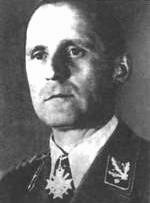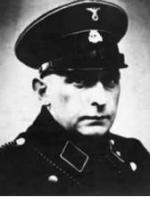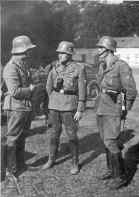 |
| Heinrich Müller |
Under the code name "Aktion 1005" the Germans tried to cover all tracks of Nazi extermination policy in the east,
by opening mass graves and cremating hundreds of thousands of bodies.
The code name had its origin in the file number 1005, used in the related correspondence between
Gestapo chief
SS-Gruppenführer Heinrich Müller and
Martin Luther, member of the foreign office. All units involved were given
the name "Sonderkommando 1005" (special command 1005).
The action was planned in
early 1942 for three reasons:
1. The Allies had obtained knowledge of German mass murder.
2. The rapidly buried victims of mass shootings and gassings became a health problem. In
Chelmno,
Auschwitz-Birkenau , the
Aktion Reinhard camps, and other killing sites
(
Einsatzgruppen) the bodies were buried in communal graves.
Very quickly, the authorities questioned this method of disposing of the corpses. Near the two first gas chambers in
Auschwitz-Birkenau
(
Bunkers I and II) the summer sun caused the
corpses to swell. The surface burst open, and a black foul smelling substance appeared, contaminating the ground
water. The horrible stench attracted millions of flies, and the whole region suffered as a consequence. The same
happened at several other sites, since the
summer of 1942 was extremely hot.
3. The Nazis thought that future generations might not understand the mass killings.
 |
| Paul Blobel * |
 |
| SD Men in Poland |
In the experimental phase,
between 1942 and 1943, the first cremations
took place at the extermination camps, supervised by
SS-Standartenführer
Paul Blobel, directly subordinated to
Müller.
Blobel developed different methods of cremation: e.g.
alternate layers of bodies and firewood, or the use of rails as grills.
During the second phase, from
June 1943 until mid 1944, the "Sonderkommando 1005" units
were ordered to open the mass graves in Poland, the Baltic states and the occupied territory of the former USSR.
Each
Sonderkommando consisted of several SD officers and members of the
Sipo and
Orpo.
One hundred Jews, sometimes more, were forced to open the mass graves, exhume and burn the bodies, and examine
the ashes for valuables. The Jewish workers were killed when the cremation process was completed.
At first the
Sonderkommando opened mass graves near the
Janowska camp in
Lviv (Lwow). In
August 1943 two units were created in
Kyiv (Kiev)
(Ukraine): "
Sonderkommando 1005-A" and "
Sonderkommando 1005-B".
"1005-A" operated in the Ukraine (between
Dnipropetrovsk (Dnjepropetrowsk) and
Berditchiv (Berditschew)), for example in
Babi Yar. There
Blobel's "
Einsatzgruppe 4a"
had shot 33,771
Kyiv Jews on
29 and 30 September 1941.
From
18 August until 19 September 1943 around 40 SS- and SD men forced 327
inmates of the
Syrets camp to
exhume and burn the bodies. Afterwards "1005-A" was ordered to
Berditchiv, Belaja Zerkov,
Uman and
Kamenets-Podolski. Because the Red Army was approaching, this
unit was then sent to
Zamosc (district
Lublin),
and finally to
Lodz for the guarding of the deportation transports from the
Lodz Ghetto to
Auschwitz.
"1005-B" cleared the mass graves in
Dnipropetrovsk, Kriwoi Rog and
Nikolaiev. Later the unit was sent to
Riga, and
was stationed at the
Salaspils camp.
In eastern Byelorussia (military district) two units were created: "
Sonderkommando 7a" and "7b". They opened
mass graves near
Gomel, Mogiljow, Bobruisk and
Vitebsk. In western Byelorussia the "
Sonderkommando 1005-Mitte"
(led by
Max Krahner) was active. It was stationed at the extermination camp
Maly Trostinec near
Minsk, where it exhumed
and cremated 40,000-50,000 bodies of Jews from
Minsk and the
Reich. Later
the unit was active in the
Molodetschno region, Brest-Litowsk, Pinsk, Kobrin and
Lomza. On
16 August 1944 the unit was ordered to
Lodz, where it guarded deportations of Jews from the ghetto to
Auschwitz.
Local
Sonderkommandos were established in several other towns and regions, from the Baltic States to
Yugoslavia (68,000 bodies).
The
Sonderkommando men finally served in Kärnten (Carinthia) in the anti-partisan unit
"
Einsatzgruppe Iltis" until the end of WW2.
"Sonderkommando 1005" trials:
Heilbronn, 1962-63:
Theimer, Rudolf - 4 Years
Criminal offenses of a section of "
Sonderkommando 1005", which was responsible for the destruction of mass graves.
Mass shooting of at least 45 Jewish prisoners of the labour commando. Individual shooting of 10 prisoners,
who had been taken to the
KL Borek for execution.
Koblenz, 1963-1965:
Dalheimer, Karl Robert - 4 Years
Harder, Arthur Alexander - Judgment annulled; no subsequent judgment
could be ascertained.
Heuser, Georg Albert Wilhelm - 15 Years
Merbach, Friedrich - 7 Years
Schlegel, Rudolf - 8 Years
Stark, Franz - life sentence
Wilke, Artur Fritz - 10 Years
Feder, Johannes Hugo Otto - 4.5 Years
Kaul, Wilhelm - 4.5 Years
Oswald, Jakob Herbert - 4 Years
Toll, Eberhard Richard Ernst von - 4.5 Years
(Polizei Sipo Minsk, Sonderkommando 1005)
Crimes committed in Minsk, HS KL Gut Trostinez, Koidanow, Rakow, Slonim, Sluck.
Shootings, gassings in "gas vans", as well as the burning alive thousands of Soviet and West European Jews, who had
been deported to Minsk, of Gypsies, mentally disabled and other Soviet civilians and Soviet agents, during the
years 1941-1944, within the jurisdictional territory of the KdS/BdS Minsk. Reprisal shootings: amongst them,
the execution of 300 men, women and children from Minsk, after the attempt on the life of Generalkommissar Kube.
Hamburg, 1968:
Drews, Otto Erich - life sentence
Goldapp, Otto Hugo - life sentence
Krahner, Max Hermann - life sentence
(Sonderkommando 1005)
Killing of Jews and other prisoners, set to work on the exhumation of the mass graves in Poland and Byelorussia
(in Minsk, KL Gut Trostinez, Pinsk, Smolewitsche, Kobryn, Slonim, Lomza), by shooting, gassing and the blowing
up of a prisoners' bunker.
Stuttgart, 1969:
Helfsgott, Walter Ernst - Acquittal
Kir., Fritz Karl - Acquittal
Soh., Hans Friedrich - 4 Years
Zie., Fritz Otto Karl - 2.5 Years
(Sonderkommando 1005A, Sonderkommando 1005B)
Unlawful shooting of Jews (mainly) and other prisoners close by the exhumation of mass graves in
Babi-Yar Ravine near Kiev, Uman, Kamieniec-Podolski, Nikolajew, Samocz, Belaja-Zerkow,
Woskresenskoje and in and around Riga.
Photo: USHMM
*
Source:
Encyclopedia of the Holocaust
Justiz und NS-Verbrechen, Vol XXVII
© ARC 2005









